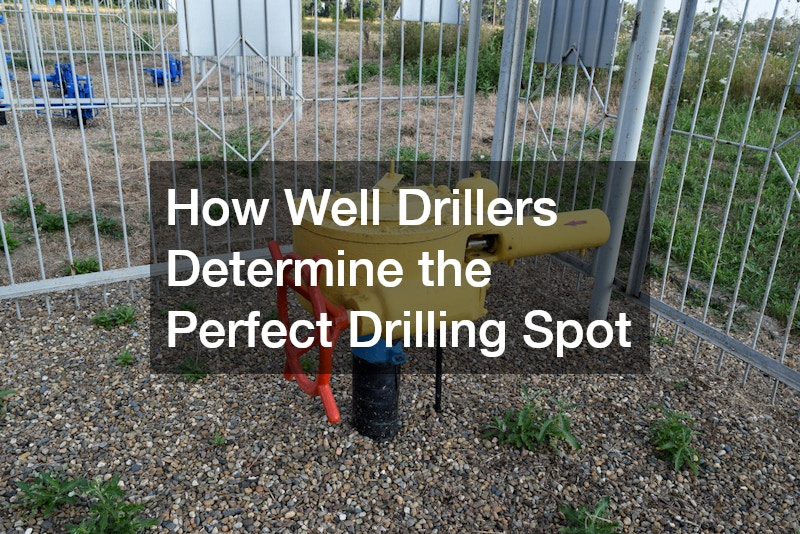When it comes to installing a private water well, the success of the project largely depends on one critical factor: choosing the right drilling location. A poorly chosen site can result in low water yields, contamination risks, and increased drilling costs. This is where experienced well drillers play a crucial role. They use a combination of technical knowledge, geological insights, and modern tools to find the perfect spot for a well.
In this article, we’ll explore how well drillers determine the ideal location for drilling, ensuring both efficiency and long-term water quality.
Understanding the Land and Geography
The first step in finding the optimal drilling location is a thorough assessment of the land. Well drillers often begin by evaluating the topography and geological characteristics of the area. Factors such as soil composition, rock layers, and slope can influence both the depth and productivity of a well.
For example, sandy soils often allow for easier drilling but may have lower water retention, while rocky terrains can indicate deeper aquifers but present challenges for drilling equipment. Additionally, well drillers look at elevation changes, natural drainage patterns, and proximity to potential contaminants such as septic systems or agricultural runoff. These natural features can affect not only the water supply but also the quality of the water drawn from the well.
Some drillers also study the history of water in the area. If neighboring properties have successful wells, the geological formations are likely favorable. Conversely, areas with a history of dry wells may require a more in-depth survey. This careful land analysis ensures that the selected site has the highest probability of a consistent and safe water supply.
Conducting a Hydrogeological Survey
Once the land has been preliminarily assessed, professional well drillers typically perform a hydrogeological survey. This survey focuses on the presence, movement, and accessibility of underground water sources, or aquifers.
Hydrogeologists use a variety of tools to evaluate water potential. These may include soil boring samples, test wells, and geophysical methods such as electrical resistivity or ground-penetrating radar. Such surveys allow drillers to measure water table levels, determine water yield potential, and identify the chemical composition of the water. Knowing these factors in advance helps avoid costly mistakes such as drilling too shallow or too deep, which can lead to low water supply or contamination.
Hydrogeological studies also provide information about seasonal water fluctuations. Some aquifers may have higher yields in wet seasons and lower yields during dry periods. Experienced well drillers use this data to position the well in areas with the most reliable water flow throughout the year, ensuring a stable water supply for households, farms, or businesses.
Assessing Legal and Environmental Considerations
Selecting a drilling spot isn’t just about geology—it also involves understanding legal and environmental factors. Well drillers must comply with local regulations regarding well placement, depth, and water usage. Zoning laws may dictate minimum distances from property boundaries, septic systems, or environmentally sensitive areas. Failing to follow these rules can result in fines, legal disputes, or even the need to relocate the well entirely.
Environmental considerations are equally important. Drilling too close to contaminated sites or areas prone to flooding can compromise water safety. Experienced well drillers collaborate with local authorities and environmental experts to ensure the chosen site meets all legal requirements while protecting the surrounding ecosystem. They may also recommend protective measures, such as well caps or filters, to minimize contamination risks. This careful planning not only reduces future maintenance issues but also ensures the well remains a safe and sustainable water source for years to come.
Using Modern Technology to Pinpoint the Best Location
In recent years, advancements in technology have transformed how well drillers identify the perfect drilling spot. Modern equipment allows for more precise, data-driven decisions. GPS mapping helps drillers pinpoint exact locations, while sophisticated software can model subsurface water flow and aquifer characteristics.
Electronic resistivity tools, seismic sensors, and ground-penetrating radar provide real-time information about underground conditions. These tools help drillers avoid obstacles like boulders or unstable soil layers and identify the depth and thickness of water-bearing formations. By combining traditional geological expertise with modern technology, well drillers can optimize the placement of wells, ensuring maximum water yield and minimal risk of complications.
Furthermore, technology allows for predictive modeling. Drillers can simulate different drilling depths and angles to determine which approach will produce the most reliable water supply. This reduces both time and costs associated with trial-and-error drilling, making the process more efficient for property owners. Ultimately, the integration of technology enhances the accuracy and reliability of well-drilling projects.
Choosing the right spot for a water well is a complex process that requires careful consideration of geological, environmental, and legal factors. Well drillers use their expertise to assess the land, conduct hydrogeological surveys, and leverage modern technology to pinpoint the most productive and safe drilling locations. By following this meticulous approach, property owners can enjoy a reliable water supply while avoiding common pitfalls associated with poorly located wells.
Whether you’re installing a well for the first time or replacing an existing one, understanding how professionals determine the perfect drilling spot highlights the value of working with experienced well drillers. From evaluating soil types to analyzing aquifer potential and navigating local regulations, the work of skilled drillers ensures that your well will provide clean, safe, and abundant water for years to come.

Related Posts
The Handy Dads Checklist: 10 Essential Repairs to Protect Your Home Investment
- The Good Dad's Home Guide
- November 10, 2025
How to Choose the Best Electricians for Your Home or Business
- The Good Dad's Home Guide
- June 4, 2025
Transform Your Home With Custom Cabinets for Storage Solutions in Any Space
- The Good Dad's Home Guide
- June 20, 2025
Signs You Need a Termite Inspection Sooner Rather Than Later
- The Good Dad's Home Guide
- June 17, 2025




